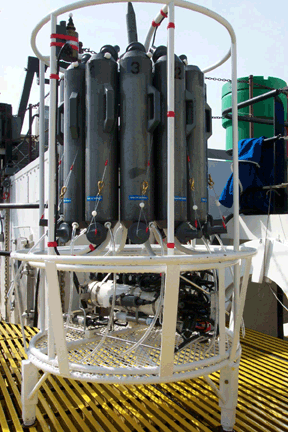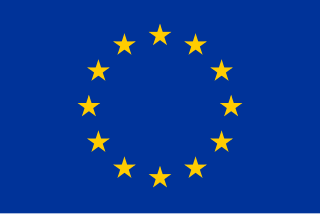Related Research Articles

Drinking water or potable water is water that is safe for ingestion, either when drunk directly in liquid form or consumed indirectly through food preparation. It is often supplied through taps, in which case it is also called tap water.

Water quality refers to the chemical, physical, and biological characteristics of water based on the standards of its usage. It is most frequently used by reference to a set of standards against which compliance, generally achieved through treatment of the water, can be assessed. The most common standards used to monitor and assess water quality convey the health of ecosystems, safety of human contact, extent of water pollution and condition of drinking water. Water quality has a significant impact on water supply and often determines supply options.

Bottled water is drinking water packaged in plastic or glass water bottles. Bottled water may be carbonated or not, with packaging sizes ranging from small single serving bottles to large carboys for water coolers. The consumption of bottled water is influenced by factors such as convenience, taste, perceived safety, and concerns over the quality of municipal tap water. Concerns about the environmental impact of bottled water, including the production and disposal of plastic bottles, have led to calls for more sustainable practices in the industry.

The Restriction of Hazardous Substances Directive 2002/95/EC, short for Directive on the restriction of the use of certain hazardous substances in electrical and electronic equipment, was adopted in February 2003 by the European Union.

The Drinking Water Inspectorate (DWI) is a section of Department for Environment, Food and Rural Affairs (Defra) set up to regulate the privatised water supply companies in England and Wales.

The European Pharmacopoeia is a major regional pharmacopoeia which provides common quality standards throughout the pharmaceutical industry in Europe to control the quality of medicines, and the substances used to manufacture them. It is a published collection of monographs which describe both the individual and general quality standards for ingredients, dosage forms, and methods of analysis for medicines. These standards apply to medicines for both human and veterinary use.
Public water supply and sanitation in the United Kingdom are characterized by universal access and generally good service quality. Unlike many other developed countries, the United Kingdom features diverse institutional arrangements across its constituent parts:. In England and Wales, water services are primarily provided by privatized companies, while in Scotland and Northern Ireland, these services are managed by publicly owned entities. Each region's unique approach is explored in separate articles, while this article is devoted to some common issues across the United Kingdom.
Water supply and sanitation (WSS) in the European Union (EU) is the responsibility of each member state, but in the 21st century union-wide policies have come into effect. Water resources are limited and supply and sanitation systems are under pressure from urbanisation and climate change. Indeed, the stakes are high as the European Environmental Agency found that one European out of ten already suffers a situation of water scarcity and the IEA measured the energy consumption of the water sector to be equivalent to 3,5% of the electricity consumption of the EU.

The Water Framework Directive (WFD)2000/60/EC is an EU directive to establish a framework for the protection of all water bodies (including marine waters up to one nautical mile from shore) by 2015. The WFD establishes a programme and timetable for Member States to set up River Basin Management Plans by 2009.

Public water supply and sanitation in England and Wales has been characterised by universal access and generally good service quality. In both England and Wales, water companies became privatised in 1989, although Dwr Cymru operates as a not-for-profit organisation. Whilst independent assessments place the cost of water provision in Wales and England as higher than most major countries in the EU between 1989 and 2005, the government body responsible for water regulation, together with the water companies, have claimed improvements in service quality during that period.
The Trade Control and Expert System (TRACES), is a web-based veterinarian certification tool used by the European Union for controlling the import and export of live animals and animal products within and without its borders. Its network falls under the responsibility of the European Commission. TRACES constitutes a key element of how the European Union facilitates trade and improves health protection for the consumer, as laid down in the First Pillar principle. Other countries use computer networks to provide veterinary certification, but TRACES is the only supranational network working at a continental scale of 28 countries and almost 500 million people.

The Urban Waste Water Treatment Directive 1991 European Union directive concerning urban waste water "collection, treatment and discharge of urban waste water and the treatment and discharge of waste water from certain industrial sectors". It aims "to protect the environment from adverse effects of waste water discharges from cities and "certain industrial sectors". Council Directive 91/271/EEC on Urban Wastewater Treatment was adopted on 21 May 1991, amended by the Commission Directive 98/15/EC.
The Biocidal Products Directive (BPD) also known as the Biocides Directive is European Union Directive, (98/8/EC), which concerns biocides. It is officially known as Directive 98/8/EC of the European Parliament and of the Council of 16 February 1998 concerning the placing of biocidal products on the market. In 2013 the Biocidal Products Directive was superseded by The Biocidal Products Regulation.
Drinking water quality standards describes the quality parameters set for drinking water. Water may contain many harmful constituents, yet there are no universally recognized and accepted international standards for drinking water. Even where standards do exist, the permitted concentration of individual constituents may vary by as much as ten times from one set of standards to another. Many countries specify standards to be applied in their own country. In Europe, this includes the European Drinking Water Directive and in the United States, the United States Environmental Protection Agency (EPA) establishes standards as required by the Safe Drinking Water Act. China adopted its own drinking water standard GB3838-2002 enacted by Ministry of Environmental Protection in 2002. For countries without a legislative or administrative framework for such standards, the World Health Organization publishes guidelines on the standards that should be achieved.

ZITIN

The Marine Strategy Framework Directive is a European Directive aimed at achieving or maintaining Good Environmental Status (GES) in European marine regions and sub-regions by the year 2020 at the latest for 11 descriptors. These descriptors include: D1 Biodiversity, D2 Non-indigenous species, D3 Commercial fish and shellfish, D4 Food webs, D5 Eutrophication, D6 Seafloor integrity, D7 Hydrographic conditions, D8 Environmental contaminants, D9 Contaminants in seafood, D10 Marine Litter, and D11 Introduction of energy, including noise.

The Data Act is a European Union regulation which aims to facilitate and promote the exchange and use of data within the European Economic Area.
References
- ↑ Carius, Alexander. "Better Reporting under the Drinking Water Directive". adelphi. Retrieved 25 April 2022.
- ↑ World Health Organization:Guidelines for drinking-water quality, third edition, incorporating first and second addenda. Retrieved 6 May 2010
- ↑ (in French) Centre d'Information sur l'Eau:Les normes de qualité de l'eau potable sont très rigoureuses Archived 2 June 2010 at the Wayback Machine . Retrieved 6 May 2010
- ↑ Eionet: Legislative instrument details: New Drinking Water Directive (consolidated)
- ↑ "Europe paves the way for revision of the Drinking Water Directive", Water 21, Journal of the International Water Association, August 2006, p. 18
- ↑ "The pivotal role of water safety plans", Water 21, Journal of the International Water Association, August 2006, p. 21-22
- ↑ "Directive review – Drinking water – Environment". European Commission. Content is copied from this source, which is © European Union, 1995–2018. Reuse is authorised, provided the source is acknowledged.
- ↑ "Excerpt" (PDF). www.iea.org. 2016.
- ↑ "EUR-Lex - 52017SC0449 - EN - EUR-Lex". Eur-lex.europa.eu. Retrieved 3 August 2018.
- 1 2 Lindqvist, Advokatfirman Lindahl-Johanna; Svitzer, Jonathan (3 February 2022). "Implementation of the new EU Drinking Water Directive". Lexology. Retrieved 25 April 2022.
- ↑ Bank, European Investment (27 February 2023). "Microplastics and Micropollutants in Water: Contaminants of Emerging Concern".
{{cite journal}}: Cite journal requires|journal=(help) - ↑ The European Commission's Environment DG web site. Retrieved 5 October 2007
- ↑ "Ofwat statement on Thames Water leakage commitments - Ofwat". 14 June 2017.
- ↑ "Thames Water's chronic leakage failures cost it dear". Global Water Intelligence.